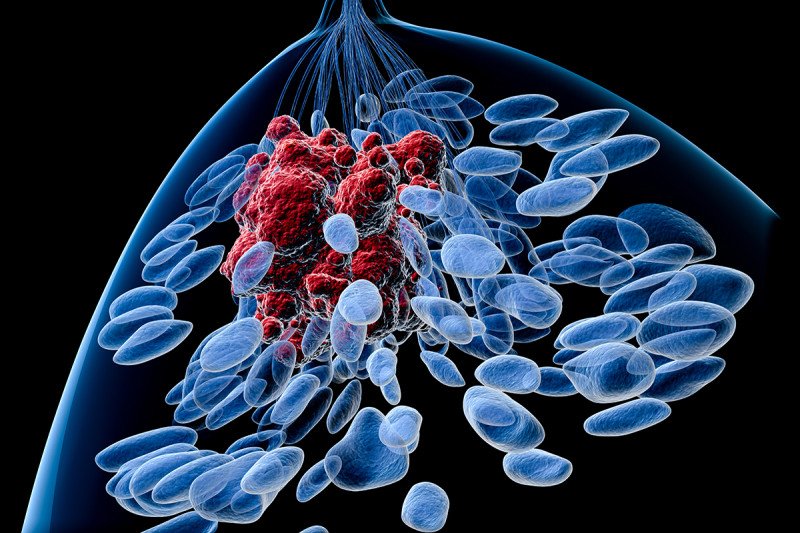
Breast cancer’s ability to develop resistance to treatment has frustrated researchers and physicians and has thwarted even the latest and greatest targeted therapies. For example, after researchers identified a disease pathway integral to many breast cancers called PI3K, they began testing experimental drugs that block this pathway — only to see the tumors then activate another pathway to fuel their growth.
But exactly how the cancer cells make this switch to a second pathway, called the estrogen receptor (ER) pathway, has been a mystery.
Now Memorial Sloan Kettering researchers report in the journal Science that they have solved a major part of this puzzle: The inhibited PI3K pathway activates the ER pathway through an epigenetic mechanism using a protein called KMT2D.
Epigenetics, the study of genetic changes not related to DNA sequence, has become a very hot field in cancer research. While epigenetic changes are known to play an important role in leukemias, lymphomas, and other cancers, this is the first evidence discovered in breast cancer.
“We’ve long known breast cancer is very plastic — you block one pathway, it adapts by activating another,” says José Baselga, MSK’s Physician-in-Chief and Chief Medical Officer. Dr. Baselga is one of the lead authors on the study.
“We now understand the mechanism by which these two important pathways ‘talk’ to each other,” he explains. “Discovering this epigenetic role opens up a whole new comprehension of how these cancer cells function.”
A Major Player
This new insight into KMT2D and its role in activating the ER pathway represents a critical advance in understanding and potentially treating the most common type of breast cancer. About 70% of breast cancers feed on estrogen to fuel growth. Among these so-called “ER-positive” tumors, 40% also have a mutation in a gene called PIK3CA, which codes for part of the PI3K protein and activates the PI3K pathway.
Although treatment strategies to block both of these pathways simultaneously have shown great promise — and are currently in phase III clinical trials — the discovery of an epigenetic link between the two could help guide long-term therapeutic strategies.
“These findings provide a strong incentive for developing epigenetic therapies in patients with PIK3CA-mutant, ER-positive breast cancer,” Dr. Baselga says.
The study, led by Dr. Baselga along with Eneda Toska, a member of his lab, and Scott Armstrong of the Dana Farber Cancer Institute, involved examining breast cancer cells from PIK3CA-mutant, ER-positive patients treated with PI3K-targeted drugs (PI3K inhibitors) in clinical trials at MSK. Using advanced experimental and computational tools to analyze the samples, they were able to pinpoint KMT2D as the protein necessary to activate ER.
“To discover that an epigenetic regulator like KMT2D is the key driver that links these two pathways is amazing to see,” says Dr. Toska, the study’s first author. “Now we will investigate further to try to find a potential therapeutic target on KMT2D. We also will look to see if there’s a broader role for this mechanism in other cancers.”
The finding of a direct association between KMT2D and the two most important pathways in breast cancer — ER and PI3K— provides the first indication that this epigenetic regulator is activating ER in breast cancer. It raises the possibility of a new process — epigenetic regulation — through which breast cancer cells are hijacked by certain genes and set on the wrong path.
“Genes coding for ER not only activate programs critical for cancer cells to grow and divide, they also shut down everything else so they can monopolize resources,” Dr. Baselga says. “It’s like an oil company making sure there is no nuclear power.”
A Complete Shutdown
Dr. Toska says that drugs blocking KMT2D given in combination with PI3K inhibitors could potentially be more effective than the current combination of PI3K inhibitors and ER drugs because blocking the epigenetic regulator would presumably shut down ER activation completely. Current ER drugs are not wholly effective at this.
“In mice, when we suppress KMT2D, we see the tumors shrink, and when we combine that with PI3K inhibitors, they shrink even more,” she says.
Dr. Baselga says using clinical observations to guide research is only possible at an institution with a large patient population and a highly advanced, efficient method for analyzing tumor samples — an institution like MSK.
“This type of discovery is the fruit of an approach based on what we see in actual patients and tumors,” he says. “We know these questions are important and the findings are not just scientifically interesting but clinically relevant. That’s what makes this place very special.”


